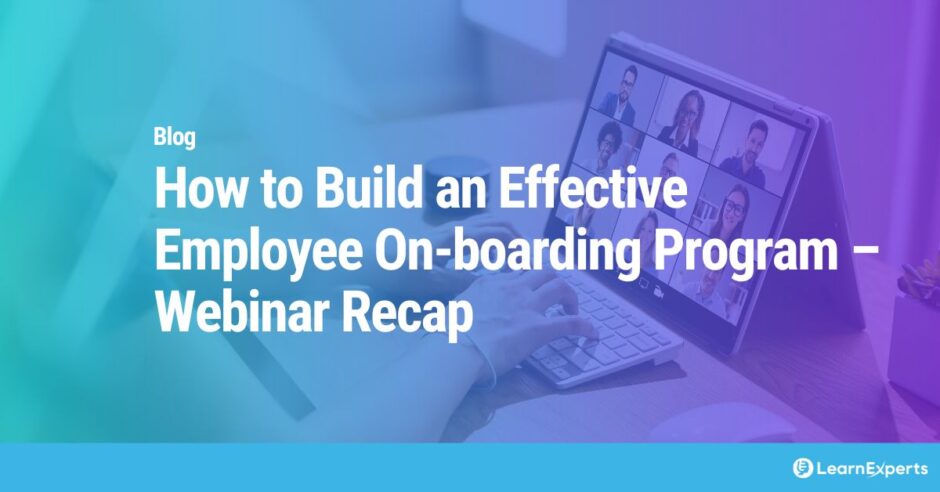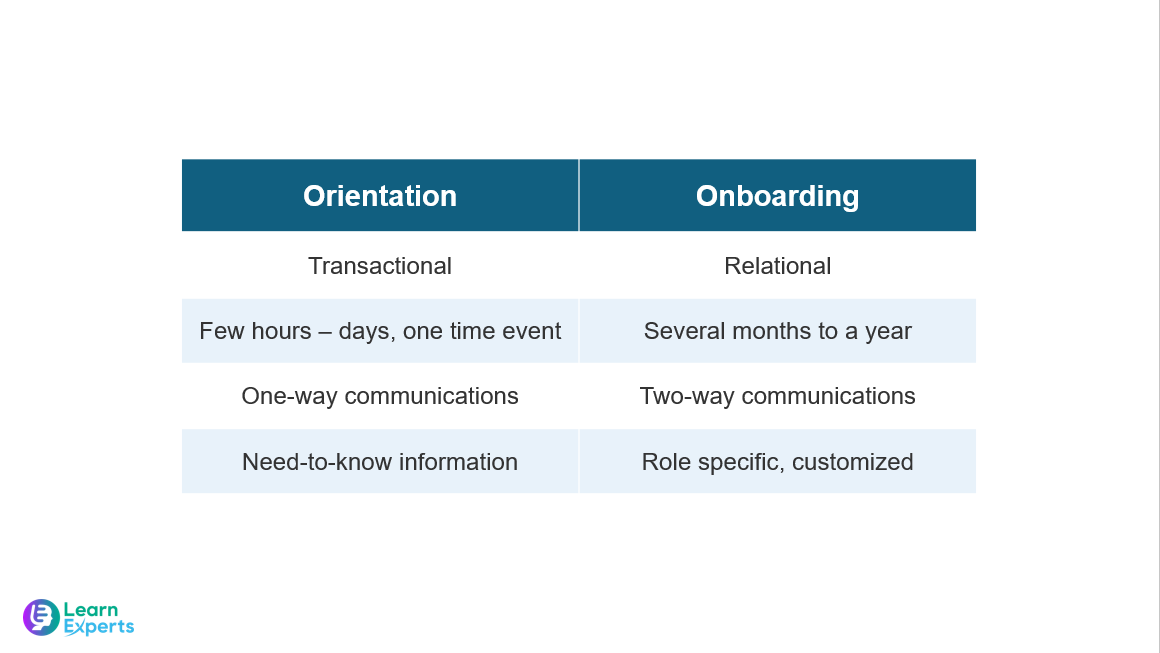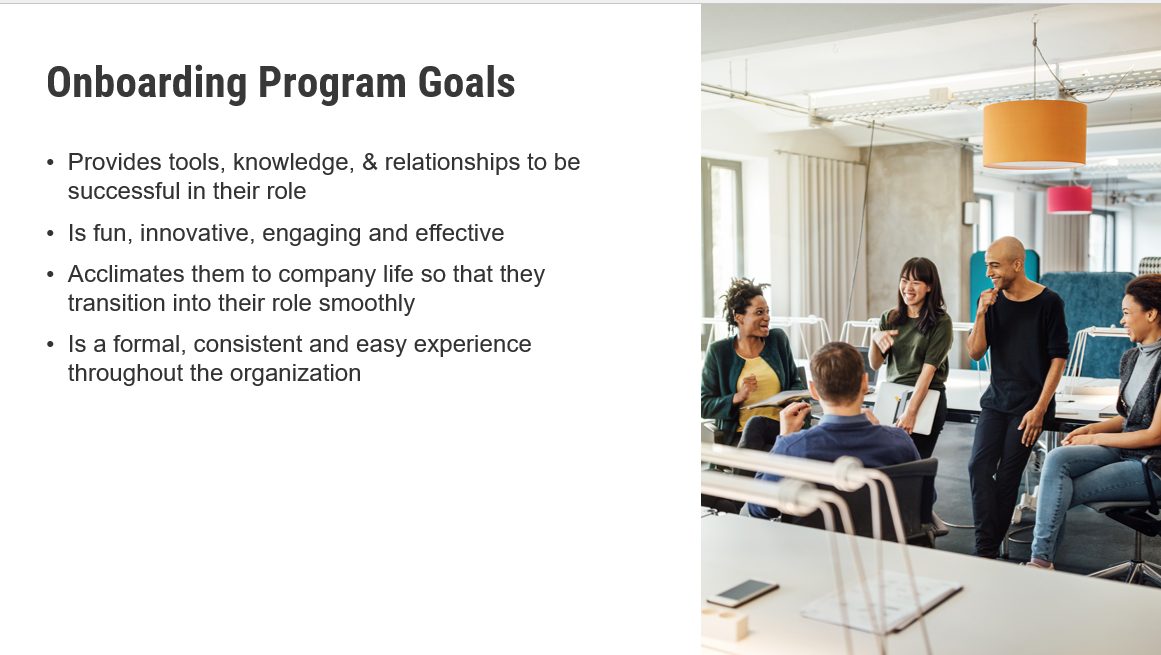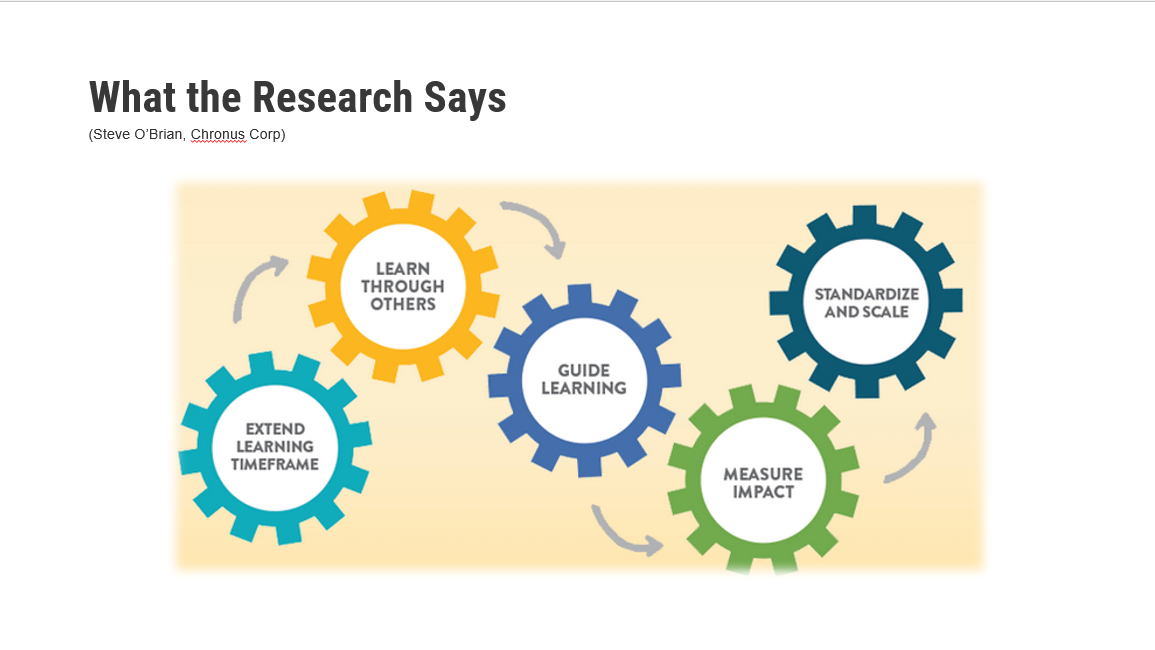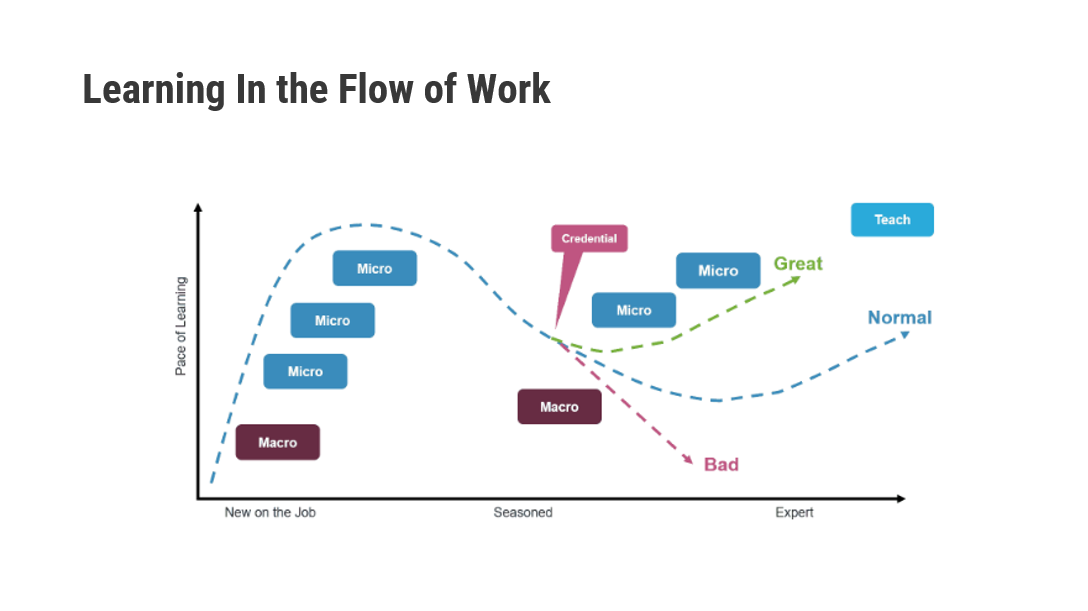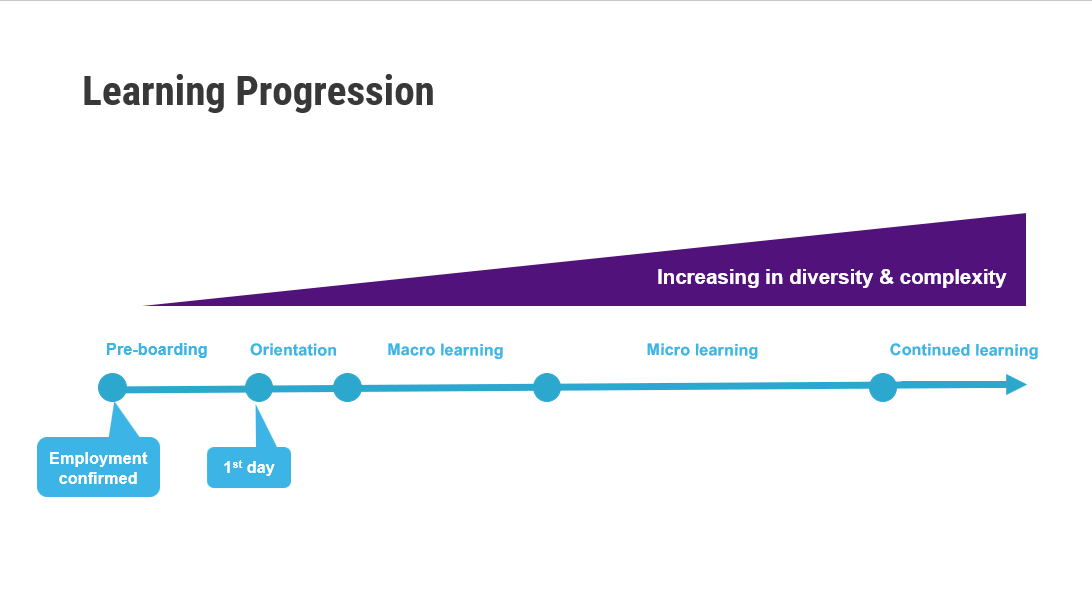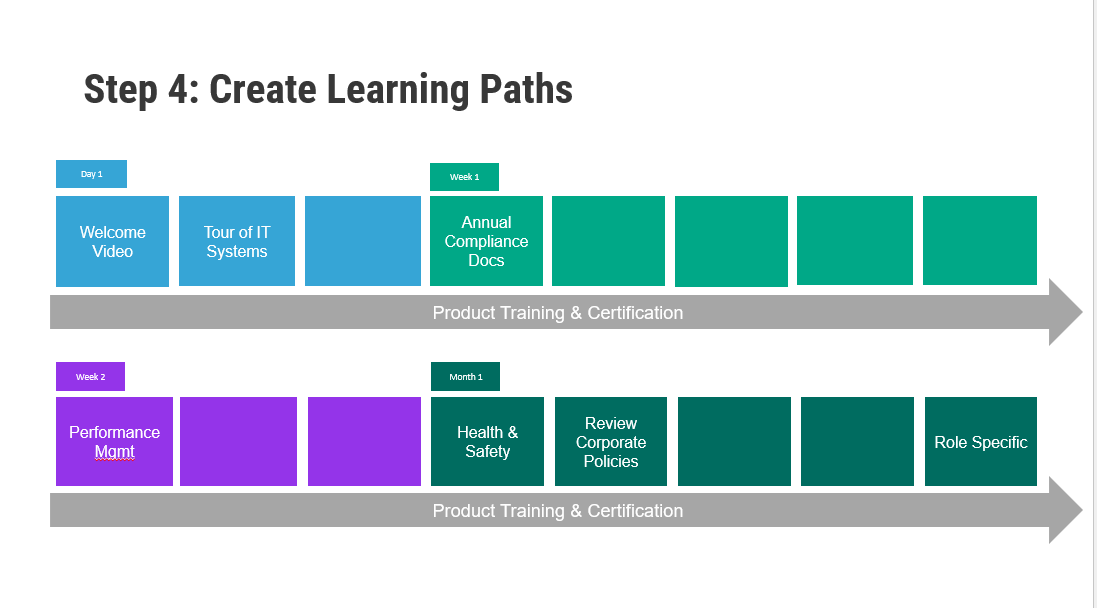Did you miss my most recent webinar on how to build an effective employee on-boarding program or want to refer to some of the information I presented? No problem! Here is a quick a view of the slides presented and a summary of key slides.
What’s the difference between orientation and onboarding?
The first topic is the difference between orientation and onboarding. They’re very different. Some organizations will call what they have onboarding, when really, it’s orientation.
Orientation is very transactional. It covers typical HR administrative activities that any organization must do to get someone up and running when they join the organization. Activities like signing papers, reading the health and safety policy, providing them with the hardware they need etc. Onboarding on the other hand is very relational. That means you’re making the relationships with the people and the tools that you need to perform your job.
Orientation is also only few hours, or maybe a couple of days, ,whereas true onboarding is several months up to a year. In that timeframe the new hire will participate in various ongoing learning activities continuously as they also work in the role for which they were hired.
Orientation is typically a one-way communication process where the HR team provides a general overview of the company, including information like the office location, their workspace, and necessary paperwork. On the other hand, onboarding is a more personalized process that is specific to the new hire’s role within the organization. The process is tailored to meet the needs of their department and provide them with the necessary tools and resources to be successful. The goal of onboarding is to help the new hire understand their job responsibilities, learn about company culture, and establish relationships with colleagues.
Orientation should still be part of the onboarding process, but it’s critical that the onboarding program be longer and broader than just getting the new hire oriented. By providing both orientation and onboarding, companies can help new employees feel more comfortable and prepared as they embark on their new career journey.
Goals of your onboarding program
Typical goals of successful onboarding programs may have slight specific differentiation from organization to organization, but typically most onboarding programs share similar objectives because the high-level goal of every program is to onboard their employees to become effective in their roles.
Successful onboarding programs typically share several common goals. The first is to provide new hires with the necessary tools, knowledge, and relationships to succeed in their new role. It’s important for organizations to create a program that is not only effective but also engaging and innovative. Another goal is to acclimate new employees to company culture and values, ensuring a smooth transition into their new role and a desire to stay with the organization long-term.
Consistency is also key. A formal, consistent, and easy onboarding experience throughout the organization is crucial to its success. Without a formal onboarding process, different departments within the same organization may create their own onboarding experiences, leading to inconsistencies and potentially negative outcomes. By setting a consistent standard, organizations can ensure that all new hires receive the same high-quality experience, regardless of department or position.
What does a successful onboarding program look like?
When it comes to creating a successful onboarding program, there are certain features that are consistently present in the best programs. By examining these features, we can gain insight into what makes an onboarding program effective and successful. So, let’s take a closer look at some of the most common features of top-notch onboarding programs that have been deemed excellent and widely shared. By understanding these features, you can implement them in your own onboarding program and increase its chances of success.
Start onboarding as soon as employment is confirmed:. As soon you have a new hire that’s signed that paper, try and find a way to engage them. This doesn’t necessarily mean overwhelming the new hire with information but can include sending a welcome video or gift to engage them.
Provide structured specific road maps (training paths): This helps new hires know what to expect during their onboarding process, reducing anxiety and improving their overall experience.
Provide required hardware right away: On that hire date, if they will be coming into the office, make sure that they have a desk space, and that the hardware that they need is there, and perhaps get IT to setup the programs that they need.
Includes social and fun aspects: You want to build a culture that new hires want to be a part of. including social and fun aspects in the onboarding process can help build a positive culture and foster a sense of community within the organization. Even for remote employees, there’s lots of ways to engage in remote activities that make them feel included, so it’s all about building those relationships whenever you incorporate those social and fun aspects.
Assigning mentors and buddies: One of the first onboarding programs that I designed; we implemented the mentor system. One of the people who was assigned as buddy still calls me his buddy to this day. The program was very effective, it created many great relationships, and we had a lot of good feedback about the program. Assigning mentors and buddies is another great feature that helps create strong relationships and provides valuable support.
Avoid mind-numbing lectures: No one wants to start off with a new job listening to all the ways that the company is great. Make sure that you have a variety of self-paced learning, instructor-led training, and fun activities.
Combine that self paced with instructor led and practical hands-on training: You really want to try and have a variety. Look at the pieces of learning that are required, and then choose appropriately whenever you’re building your path. Combining self-paced with instructor-led and practical hands-on training creates a diverse learning experience that caters to different learning styles.
Measure effectiveness of program and implement ongoing updates: This is key to ensuring the program meets the organization’s needs and continues to be effective over time. Remember, onboarding is not a “set it and forget it” process, but rather an ongoing initiative that requires evaluation, iteration, updates and improvement.
What does the research say about learning?
Extend the learning window: Studies suggest you extend onboarding programs for at least six months to achieve effective learning saturation. Also keep in mind that beyond speed to competency, employees are still in the process of “buying in.” In fact, 90% of employees are still deciding whether they’ll stay at an organization throughout their first six months.
Incorporate Learning Through Others: Including a personalized, 1:1 approach to your extended onboarding program greatly improves learning retention, since this is how we, as people, naturally want to learn.
Guide the Learning: Just like classroom learning, it’s important to provide a structure for any extended informal or hands-on learning. Creating a training path for the entire length of your onboarding program ensures that learning is continuous and productive, speeding your new hire time-to-productivity.
Measure Impact, Iterate, and Scale: Once you’ve built and launched your program it is critical to measure the impact, update it as necessary and ensure that it can scale. Would it be wonderful to have highly individualized, gamified in-person learning for the whole onboarding program? Sure! Will that scale – heck no! You’ve got to have the right mix of fun, information, and standardization to make sure you can scale your program. Include a variety of training types in your program like eLearning, instructor-led, videos and knowledge articles along with 1-on-1 sessions and ensure that the program is repeatable.
How to setup your learning as employees grow
Josh Bersin created this Learning in the Flow of Work; it really was the catalyst for the recent buzz around microlearning. But the intention of this was not to replace traditional longer training with microlearning entirely, but to show how to use both in the most effective way.
Early in a role, we need “macro learning” to get started: understanding the job, the domain, the people, the systems. As we progress up the learning curve, we need continuous injections of new skills, information, and connections to proceed – until we become an expert.
Then we tend to become the “coach” and we teach others, moving in a more horizontal way, until we reach the next level of proficiency, role, or promotion to energize our career. At that point we may need another “macro learning” intervention to go back up the learning curve, or if we fail we may actually get bored and leave.
Learning paths for onboarding programs
When creating an onboarding learning path for an organization, there is a process that can be followed to ensure success. The first step is to determine the roles that require training and the main business outcomes that need to be achieved with the training. For onboarding, this includes everyone in the organization becoming proficient in their roles as quickly as possible, but it’s also important to consider specific outcomes for individuals based on their department or role.
Once the roles and outcomes are established, the high-level tasks and knowledge required for each role are identified and entered into a matrix to look for areas of overlap. These areas of overlap are where the focus should be at the start of the learning path.
The next step is to create the learning paths. This process can be a combination of experience and collaboration with subject matter experts. It’s important to group tasks together in a logical way and consider a mix of self-paced learning, instructor-led training, and practical hands-on training. By following this process, organizations can create effective onboarding learning paths that help new hires transition smoothly into their roles and become successful members of the team.
Sample onboarding learning path
For onboarding, it’s easy to start with a generic path and then branching off to different roles. The graphic above shows a generic sample path with some common courses you might find in an onboarding path included along with some blanks that would represent other pieces of learning.
Providing the visual path is particularly helpful for new hires, especially for the learners to understand what that journey is, what kind of training they’re taking and when. Typically as part of a visual path like this I would also add the modality of the training (instructor-led, eLearning, knowledge article, etc.) and how long each piece of learning is.
Day one is very overwhelming for new hires. You really want to try and keep day one to the absolute necessary things that they need to because they’re going to be getting acclimated, finding their desks, getting their systems set up. In week one, there will be elements that they need to achieve, and then a week two, and then in month one. Once they completed the generic onboading path that applied to all new hires you’ll see the last piece reads “Role Specific”, at that point new hires should move on to the onboarding path for their role or department to learn the specific that apply to them. This role-specific path may also begin within the first week or two and have overlap with the generic path – in which case I would recommend combining them into one view for the new hire.
The last component is what you see in the gray. If you have a complex product or solution, you want to try and sprinkle product/solution training throughout your onboarding.
Check out the checklists in our blog on employee onboarding phases!
Building content for your onboarding program
A good onboarding program is a great way to empower new hires and increase their chance of success. But it can be a real struggle to build the content for these well-thought-out learning paths.
LEAi is our online learning content development tool, and it helps to quickly create learning content for online courses, step-by-step execution guides, product training, presentations, microlearning, videos, instructor-led training and more. It simply imports your PDFs, Word documents and PowerPoint presentations and creates the training content for you.
If you don’t have the time to build your courses, LearnExperts also offers consulting services that will help you scale the development of learning content so you can quickly your new employees, regardless of their roles.
To learn more about what I presented during the webinar or how we can support your onboarding program, contact us!

